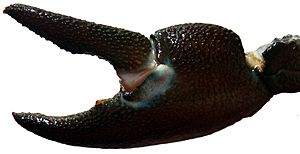Signal crayfish facts for kids
The signal crayfish (Pacifastacus leniusculus) is a type of crayfish that originally comes from North America. It was brought to Europe in the 1960s to help with fishing for the native European crayfish, Astacus astacus. Sadly, the native crayfish were getting sick from a disease called crayfish plague.
However, it turned out that the signal crayfish were carrying this disease themselves! They didn't get sick from it, but they spread it to the European crayfish, which then died. Because of this, the signal crayfish is now seen as an invasive species in many places like Europe, Japan, and California. This means they spread quickly and often harm or push out the native animals.
Quick facts for kids Pacifastacus leniusculus |
|
|---|---|
 |
|
| Conservation status | |
| Scientific classification | |
| Genus: |
Pacifastacus
|
| Species: |
leniusculus
|
Contents
What does the signal crayfish look like?
Signal crayfish are usually about 6–9 centimetres (2.4–3.5 in) (2.4 to 3.5 inches) long. Some can grow much bigger, up to 16–20.32 centimetres (6.30–8.00 in) (6.3 to 8 inches)! They are usually bluish-brown or reddish-brown.
They have strong, large, and smooth claws. You can tell them apart from other crayfish by a special white or pale blue-green spot near where their claws connect. This spot looks a bit like the white flags that train signalmen used to use, which is how they got their name!
Life cycle and diet
The way signal crayfish grow and reproduce is similar to other crayfish in their family. In the autumn, after mating, a female crayfish lays about 200 to 400 eggs. She carries these eggs safely under her tail until they are ready to hatch the next spring.
When the eggs hatch, tiny juvenile crayfish appear. These young crayfish go through two molts (shedding their outer shell) before they leave their mother. They become old enough to reproduce themselves after two or three years. Signal crayfish can live for a long time, sometimes up to 20 years!
Signal crayfish are omnivores, which means they eat both plants and animals. Most of their food is detritus, which is dead plant and animal matter. They help clean up their environment by eating this decaying material.
Where do signal crayfish come from?
The signal crayfish is originally from North America, specifically west of the Rocky Mountains. This includes places like British Columbia in Canada, and the U.S. states of Washington, Oregon, and Idaho.
They were first brought to California in 1912. From there, they quickly spread all over the state. In California, there is only one native crayfish left, called the Shasta crayfish. People are working hard to stop the signal crayfish from invading the areas where the Shasta crayfish live.
Signal crayfish have also been introduced to other parts of North America, like Nevada and possibly Utah. They have even been found in Alaska, on Kodiak Island. The IUCN Red List considers the signal crayfish a species of least concern, meaning it is not currently at risk of disappearing in its native home.
Why were they brought to Europe?
Starting in 1907, a serious disease called crayfish plague began to harm the native European crayfish, Astacus astacus. This disease is caused by a type of water mold called Aphanomyces astaci.
Because the signal crayfish lived in a similar environment in North America, people thought they could be a good replacement. So, in the 1960s, signal crayfish were brought to countries like Sweden and Finland. The idea was to help people continue to catch crayfish for fun and for business.
At that time, people didn't realize that the signal crayfish carried the crayfish plague. All American crayfish species carry this infection, but it usually only makes them sick if they are already weak. However, for European crayfish, this infection is deadly and kills them very quickly.
Spread across Europe
Today, the signal crayfish is the most common non-native crayfish in Europe. It can be found in 25 different countries, from Finland all the way to Great Britain and from Spain to Greece. It first arrived in Great Britain in 1976 and has now spread across the British mainland. It has also been seen on the Isle of Man.
Interestingly, Ireland is the only European country that does not have any non-native crayfish. In countries like Sweden and Finland, where crayfish are a popular food, more signal crayfish are caught than the native noble crayfish. However, signal crayfish are usually sold for about half the price of the noble crayfish.
|
See also
 In Spanish: Cangrejo señal para niños
In Spanish: Cangrejo señal para niños




